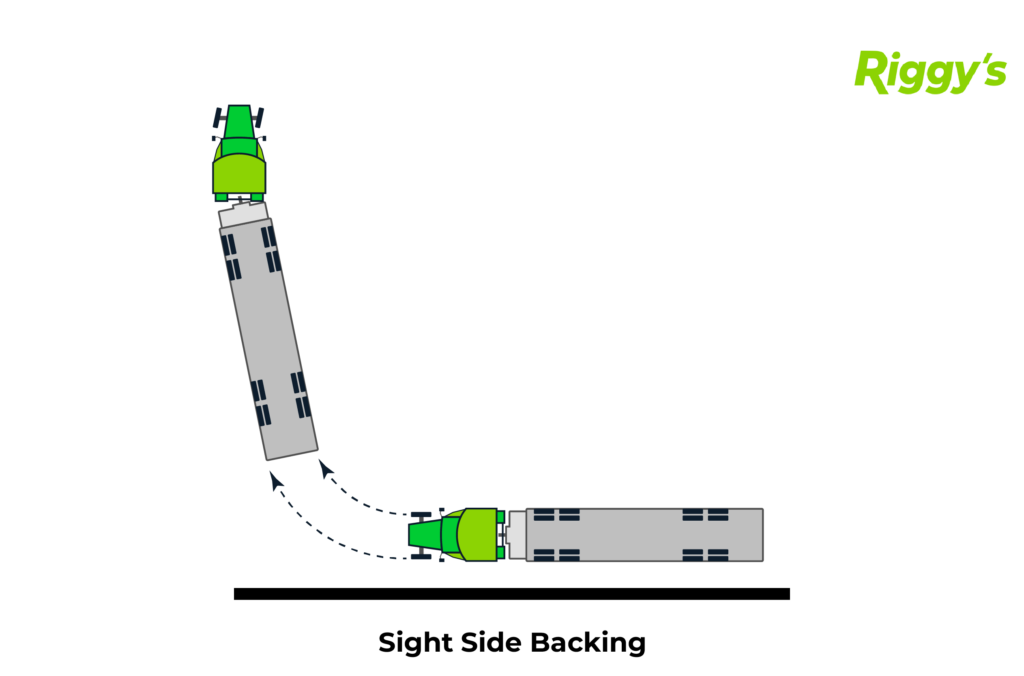While perhaps initially challenging, sight side backing offers one of the most preferable ways of maneuvering a truck into a spot. This process involves backing toward the left side of the vehicle where the driver can see the intended trailer path. Sight side backing is preferred as the driver has maximum visibility.
Sight side backing is often compared to its cousin, blind side backing. It offers a preferable alternative as it offers increased visibility and reduced complexity.
Process of Performing Safe Sight Side Backing
Being a heavy-vehicle driver requires extra care whenever backing into tight spaces. The challenge imposed by the tractor-trailer connection makes it an activity suited to professional drivers only. Good thing you are one.
Here’s how to perform safe sight side backing like a pro:
Identify The Spot
The first step is to identify the spot and ensure enough space to back your truck without damaging surrounding cars or other property.
Maneuver to a Parallel Position
Ensure you are as close to the spot as possible where you can safely get your vehicle into the parking spot. Your tractor-trailer should be parallel to the parking spot. It ideally should be about one and a half spaces ahead of the intended parking area.

Aligning The Shoulder
Now that you have aligned your vehicle parallel to the spot, align your shoulders with the curb or barrier to the driver’s side impediment. This intentional alignment forces you to look backward and helps you scan for any impediments. It allows further attunes you to the truck’s movement and provides a stable point of view where continual head movement is not required.
Turning the Truck
When you’ve lined your shoulder correctly, turn the wheel entirely to the right and reverse until the trailer is at 90 degrees; parallel to the parking spot. Subsequently, spin the wheel 45 degrees to the left. This allows for visibility to the driver-side tandem.
Now, crank the wheel towards the right and aim for the driver-side yellow line, sharpening the approach angle. Though this technique assists in proper backing, the risk of hitting the passenger side is high, so always check your sides.
Backing

Now that your vehicle is ready to reverse, go as far back as possible while keeping an eye on your left and right side. Keep in mind that this is the spot where your vehicle may swing right more than expected when you straighten the steering.
Sight Side Backing vs. Blind Side Backing
Sight-side backing refers to backing towards the left side of the vehicle where the driver can see the trailer path. Blindside backing backs towards the right side of the trailer, where the driver can only see in the rear-view mirror.
This reduction in visibility makes the blindside backing process more challenging and subsequently more dangerous. Drivers should opt for sight side backing whenever possible.
Conclusion
Sight side backing is a preferred choice for commercial drivers as it allows better visibility and reduces the chances of collision with nearby vehicles. Make sure to carry out safety precautions before backing your trailer and check for enough space.
Commericial truck lots often don’t consider the parking process a driver has to undergo in their lot.. When the choice exists, always choose a lot that allows for sight side backing to reduce the risk of accidental collisions.
Line your shoulder with the spot next to where you want to park and turn the trailer at an angle. Most expert drivers hug the right side of the trailer not to hit the adjacent vehicles when backing.
Frequently Asked Questions
What are two types of backing?
The two main types of backing are sight side and backside backing. Sight side backing is also known as driver side backing, where drivers offset back to the left. Alternatively, blind side backing refers to backing to the right.
What is the proper backing technique?
A truck driver who is actively aware of their body will be more attuned to their rig. As such, turn your body and head to get the most view of the surroundings. Align their shoulders properly, drape their right arm over the seat, and hold the steering wheel firmly while reversing.
Perhaps most importantly, don’t feel rushed. In some circles, this truly American phenomenon is known as “Hurry Sickness”.
What are the challenges associated with parking a tractor-trailer?
Backing up a tractor-trailer does not compare to backing up a passenger vehicle. Reversing in a passenger vehicle means that turning the wheel right pushes, the end of the vehicle to the right. A tractor-trailer has a pivot point, meaning that the trailer goes in the opposite direction of the way you turn the wheel.
